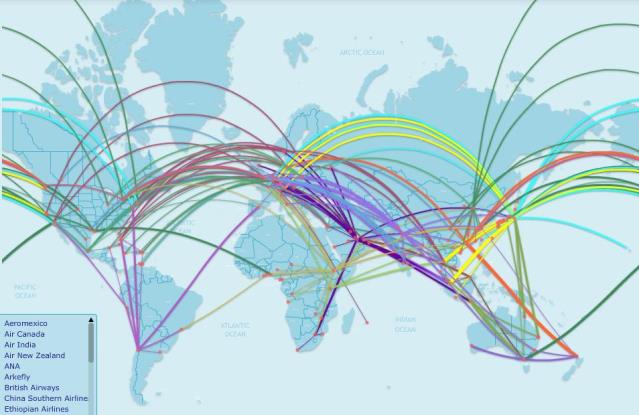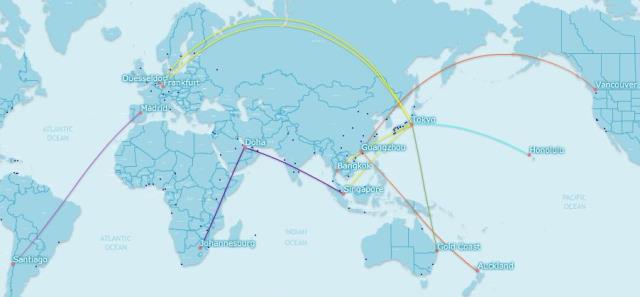Three years after the Boeing 787's long-awaited entry into service, Henk Ombelet from Flightglobal's Ascend consultancy looks at whether the Dreamliner has changed the market
Much has been made about the capability of the Boeing 787 to operate on long thin routes profitably. The aircraft was presented as a "hub buster"; rather than flying large aircraft between hubs and then single-aisle aircraft to the final destination, the 787 would allow airlines to bypass hubs and fly direct to smaller destinations.
The aircraft has been in service for three years as All Nippon Airways took delivery of the first 787 back in September 2011. Since then, 198 more have been delivered to 25 airlines around the world, all but seven the -8 variant. ANA is the largest operator with, currently, 33 aircraft. Half of the total are with airlines in the Asia-Pacific region, with the remainder spread over the other continents.

The number of seats installed varies substantially. For the -8, the smallest number of seats is on one of the ANA variants which only has 169 seats. It goes all the way up to 335 seats for Jetstar, which still manages to squeeze in three rows of business class but makes up by having nine seats across in economy. ANA and JAL are the only airlines that have eight-abreast in economy.

ANA is also the only airline that varies the number of seats across its 787s. All other airlines have so far stuck to a single configuration. Not surprisingly, the low-cost and charter airlines have the highest-density configurations – mostly by not having business class and only a small premium-economy section.
All network carriers have a business class on the aircraft, but only one airline has a first class – China Southern having exactly one row of first-class seats, though it remains to be seen how viable such a configuration will prove. Among the network carriers, Ethiopian Airlines and Royal Jordanian have the highest number of economy-class seats at 246, while ANA has the largest number of business-class seats at 46 – although with a 44in seat pitch, these are aimed at use on a short- to medium-haul network.
NETWORK
Flightglobal's Innovata schedules for November 2014 show 25 airlines operating 787s on a total of just over 250 routes with around 12,000 flights per month. With 200 aircraft, this equates to an average of 60 flights per month or two flights per day.
All but one of the 10 busiest routes by flight number at the moment are from Tokyo Haneda, and all but one of those are domestic routes operated by ANA. The only international route is to Taipei Sungshan airport, which both ANA and JAL serve with the Dreamliner. The only route of the 10 largest using 787s is a domestic route between Guangzhou and Beijing, operated by both China Southern and Hainan.
However, judging from the seat counts (the schedules data for ANA does not distinguish between the -8 and -9) it appears most of the Japanese domestic flights are operated by the 787-9, which for ANA has a high-density configuration with 377 economy seats, plus only 18 business-class seats with a seat pitch of 50in. Clearly, the 787 usage that the Japanese airlines had in mind was, initially at least, as domestic workhorses. Whether this is a good use of an aircraft built for long-haul remains to be seen.
Looking at how the 787 is used by number of flights gives one view, but is skewed toward the shorter flights. It is not really representative of how the 787 is utilised in general. Clearly the longer routes will dominate if kilometres flown is used as a proxy for utilisation, but it does give a better picture on where the aircraft are being utilised.
The 10 largest 787 routes by ASK (November 2014)

The other issue is that the short-haul use of the 787 is dominated by ANA. This airline is currently the largest operator of 787s (and will remain so based on the current orders), but it uses the aircraft disproportionately on short-haul. Separating the ANA figures out of the general fleet illustrates this impact.
The 24 airlines operating the 787 operate a total of 585 long-haul routes (>5,000km). They have started a total of 55 new 787 routes over the last three years. All new routes are of course long-haul, and it means a 10% increase over the last three years due to the 787. However, the airlines opened another 140 long-haul routes as well with other aircraft.
Where the 787 replaced other aircraft on an existing route, it typically replaced a Boeing 767 or 777. This is not to say that an airline is more likely to replace a 787 with another Boeing, just that the current 787 operators have more Boeing than Airbus aircraft in their existing fleet. The effect on the overall capacity of the replacements is mixed. Looking at existing routes where a 787 was introduced in 2014, the capacity (measured in seats) went down on 23 routes, while on the remaining 44 it increased, partly because on a number of routes the 787 was used alongside other aircraft.
For short-haul routes, the picture is much more complicated, as on many routes several different aircraft are operating and it cannot really be established which aircraft was replaced by a 787.
Norwegian has started the most new routes. The airline timed its launch of long-haul services to coincide with taking delivery of the 787 – though delays in the programme meant it actually launched long-haul flights with leased A340s. It has based its long-haul business model around the aircraft, expecting to be able to compete with low fares by having a technologically advanced aircraft in a high-density configuration giving lower operating costs than its competitors.
New 787 routes (November 2014)

One of the arguments for the 787 development by Boeing has been around the aircraft being able to open long thin routes bypassing hubs. Looking at the traditional carriers that operate the 787, every single new route has a hub airport at least at one end of the route. And of course, unless a route is between hubs, it bypasses one hub. Take for example the three new routes that JAL has opened with its 787: Helsinki, San Diego and Boston. Helsinki is a hub of Oneworld partner Finnair, which already operated the route. San Diego and Boston are not Oneworld hubs. Previously, a passenger wanting to travel between San Diego or Boston and Tokyo would have to make a connection through one of the other 16 airports on the US mainland that has a flight to Tokyo. So there is clearly a passenger benefit in having such a flight: fewer connections, shorter travel time.
However, the increase in destinations that JAL serves in the USA has not led to a decrease in hub flying. In 2011, JAL flew to four US cities, all served daily using 777s. Three of those are American Airlines hubs: Chicago, New York JFK and Los Angeles. By 2014, flights to JFK had doubled with a 787 service added to the 777 fights. The only destination that has seen a reduction is non-American hub San Francisco, where the 777 was replaced by a 787. But total service to the USA has increased from four daily flights in 2011 to seven this year.
Long-haul, it is rare for a legacy airline to operate a route that does not originate in one of its hubs or at least its focus cities. There are a few of these routes, typically to particular leisure destinations from smaller airports in the airline's home country. By and large, however, long-haul routes emanate from a hub, and all the current 787 routes for legacy airlines do as well.
Of the 106 routes operated by legacy carriers, 32 actually operate between hubs of alliance partners. Another 74 are typical hub-to-spoke routes. The real spoke-to-spoke routes are operated by the low-cost long-haul airlines such as Jetstar and Norwegian, as well as the charter airlines such as the three TUI airlines: Thomson Airways, Jetairfly and Arkefly.
It seems that for legacy and charter airlines, the 787 currently provides a more cost-effective alternative with a seat count somewhere between the 767 and the 777 that airlines can use to develop their predominantly hub-and-spoke networks. Few of the airlines appear to utilise the full range of the aircraft. It seems it could be potential long-haul low-cost operators that might challenge this model on new "long thin" routes, but would do so with the assistance of a high-density seating arrangement to reduce unit costs.

Source: Cirium Dashboard



















